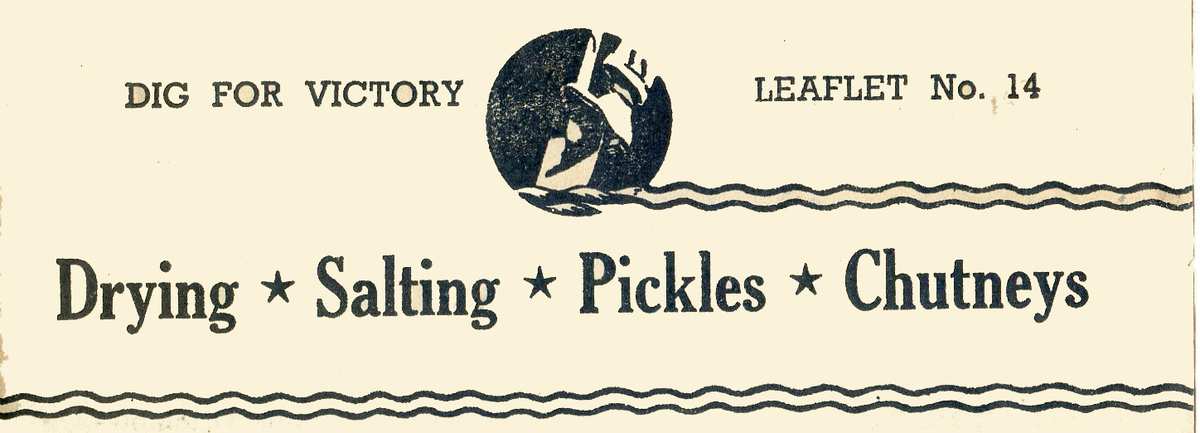 Drying * Salting * Pickles * Chutneys
Drying * Salting * Pickles * Chutneys
DIG FOR VICTORY LEAFLET No. 14 (Page 1 of 4)
DRYING
CERTAIN fruits and vegetables can be dried in the home quite simply and without expensive apparatus.
The fruits that dry best are apples, grapes, pears and stone fruits, but some varieties, especially of plums, are more suitable than others. Soft fruits and berries are not generally satisfactory.
Leafy and root vegetables are best used in the fresh state whenever possible. Peas, beans and, of course, herbs, may be dried, but most other vegetables are best dealt with by storing them in the ways set out in ” Dig for Victory Leaflet ” No. 3, or preserving them by other means.
Equipment
All that is required is a number of trays made from four wooden laths nailed together to form a square that fits into the oven, drying cupboard or plate-rack. Wire gauze or canvas is nailed over the framework, and the trays are covered with muslin to prevent the fruit from sticking.
Temperatures
Great heat is harmful : scorching must be avoided. When an oven is used, the door should be kept ajar, and the temperature should never exceed 150°F. Drying can well be done with the heat that remains in the oven after cooking is finished, drying being continued on several days if necessary.
A plate-rack over the fire can often be used, but care must be taken to ensure that smoke does not pass through it. A drying cupboard is also suitable, but the process will probably take longer.
Fruit
Fruits should be fresh and just ripe ; dried at this stage, they retain their colour and flavour better. Most fruits should be halved or sliced, as this hastens the process. Grapes or small plums, however, are usually dried whole.
The fruit should be dried to a leathery consistency but not hard. The time required will depend on the temperature, and may be anything from about 4 hours for apple rings at a temperature of 140°F., to 12 hours or more for juicy varieties of plums. Occasional turning will hasten the process.
Vegetables
Vegetables for drying should be young and fresh, and most kinds first need blanching in boiling salted water for about 5 minutes. They are then put into cold water and drained well.
String beans should be sliced in the usual way, and dried till brittle. Broad beans should be shelled. Only a few varieties of peas (chiefly the Marrowfats or Blue Marrow varieties, such as Harrison’s Glory) are suitable for drying by artificial heat, and they should be gathered when young and tender. Mushrooms should be peeled, and dried without blanching till crisp.
Natural Drying
Surplus beans and peas of most varieties can be air-dried. The most suitable for drying, however, are the haricot beans such as Comtesse de Chambord. Dutch Brown or Inépuisable.
Green pods should not be picked, but all allowed to ripen on the plants as far as possible. The whole plants are then lifted, tied in bundles and hung up to finish drying in an airy place, before removing the seeds from the pods.
Packing
Dried fruits or vegetables should be left to cool before packing in jars, tins, boxes or paper bags. If sufficiently dried and kept in a dry place, they should keep well for many months.
Using
Dried fruits and vegetables should be soaked overnight or longer before they are cooked, until they regain their normal size. They should be brought to the boil slowly in the water in which they have been soaked, and boiled gently until tender.
Sugar added to fruit should be put in just before cooking is finished ; this prevents toughness.
Herbs
Gathered just before the plants flower, herbs should be washed, tied in bundles, protected from dust with a piece of muslin, and hung up to dry near a fire.
The leaves of the larger kinds may be picked from the stalks, blanched in boiling water and dried in a cool oven at a temperature of 110° F. to 130°F. The leaves should be dried until quite crisp, and then crushed or sieved to a powder and stored in bottles or tins away from the light.
Parsley keeps its colour better if it is placed in a very hot oven for one minute rather than dried slowly, but it must not be scorched.


